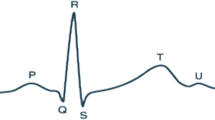Abstract
Emerging body sensor networks (BSN) provide solutions for continuous health monitoring at anytime and from anywhere. The implementation of these monitoring solutions requires wearable sensor devices and thus creates new technology challenges in both software and hardware. This paper presents a QRS detection method for wearable Electrocardiogram (ECG) sensor in body sensor networks. The success of proposed method is based on the combination of two computationally efficient procedures, i.e., single-scale mathematical morphological (MM) filter and approximated envelope. The MM filter removes baseline wandering, impulsive noise and the offset of DC component while the approximated envelope enhances the QRS complexes. The performance of the algorithm is verified with standard MIT-BIH arrhythmia database as well as exercise ECG data. It achieves a low detection error rate of 0.42% based on the MIT-BIH database.









Similar content being viewed by others
References
Friesen, G. M., Jannett, T. C., Jadallah, M. A., Yates, S. L., Quint, S. R., & Nagle, H. T. (1990). A comparison of the noise sensitivity of nine QRS detection algorithms. IEEE Transactions on Bio-Medical Engineering, 37, 85–98.
Kohler, B. U., Hennig, C., & Orglmeister, R. (2002). The principles of software QRS detection. IEEE Eng. in Medicine and Biology Magazine, 21, 42–57.
Peelers, R. L. M., Karel, J. M. H., Westra, R. L., Haddad, S. A. P., Serdijn, W. A. (2006) Multiwavelet design for cardiac signal processing. in Proc. of 28th Int. Conf. of the IEEE EMBS.
Rodrigues, J., Olsson, L., Sörnmo, T., & Öwall, V. (2005). Digital implementation of a wavelet-based event detector for cardiac pacemakers. IEEE TCAS-I, 52(12), 2686–2698.
Zhang, F., Wei, Y., & Lian, Y. (2008). Efficient QRS detection in wearable ECG Devices for body sensor network. The 5th IEEE International Workshop on Wearable and Implantable Body Sensor Networks, Hong Kong, China, Jun 1–3.
Zhang, F., Wei, Y., & Lian, Y. (2009). Frequency response masking based filter bank for qrs detection in wearable biomedical devices. IEEE International Symposium on Circuits and Systems, Taipei, Taiwan, May 24–27.
Gasterators, A., Andreadis, I., & Tsalides, P. H. (1998). Fuzzy soft mathematical morphology. IEEE Proceedings Vision, Image and Signal Processing, 145, 41–49.
Zhang, F., Li, C., & Shi, L. (2005). Detecting and tracking dim moving point target in IR image sequences. Infrared Physics and Technology, 46, 323–328.
Chu, C.-H. N. & Delp, E. J. (1989). Impulsive noise suppression and background normalization of electrocardiogram signals using morphological operators. IEEE Transactions on Biomedical Engineering, 36, 262–273.
Trahanias, P. E. (1993). An approach to QRS complex detection using mathematical morphology. IEEE Transactions on Biomedical Engineering, 40, 201–205.
Chen, Y. L., & Duan, H. L. (2005). A QRS complex detection algorithm based on mathematical morphology and envelope. in Proc. of 27th Annual International Conf. of the IEEE EMBS, Shanghai, China, pp. 4654–4657.
Zhang, F., Tan, J., & Lian, Y (2007). An effective QRS detection algorithm for wearable ECG in Body Area Network. in Proc. of IEEE International Conf. on Biomedical Circuits and Systems.
Zhang, F. & Lian, Y. (2009). QRS detection based on multi-scale mathematical morphology for wearable ECG devices in body area networks. IEEE Transaction on Biomedical Circuits and Systems, 3(4), 220–228.
Maragos, P., Schafter, R. W., & Butt, M. A. (1996). Mathematical morphology and its applications to image and signal processing, 1996 by Kluwer Academic.
Oppenheim, A. V., Schafer, R. W. (1989). Discrete-time signal processing, Prentice-Hall, Englewood Cliffs, NJ, pp. 775.
Whalen, A. D. (1975). Detection of signals in noise, Prentice-Hall Inc.
Zhou, S. K., Wang, J. T., & Xu, J. R. (1988). The real-time detection of QRS complex using the envelop of ECG. in Proc. of 10th Annual IEEE EMBS International Conference.
Nygards, M. E. & Sornmo, L. (1983). Delineation of the QRS complex using the envelope of the ECG. Medical and Biological Engineering and Computing, 21, 538–547.
Zhang, F., & Lian, Y. (2007). Novel QRS Detection by CWT for ECG Sensor. IEEE International Conference of Biomedical Circuits and Systems, Montreal, Canada, Nov 27–30.
Available: http://www.physionet.org/physiobank/database/mitdb/
Poli, R., Cagnoni, S., & Valli, G. (1995). Genetic design of optimum linear and non-linear QRS Detectors. IEEE Transactions on Biomedical Engineering, 42, 1137–1141.
Pan, J. & Tompkins, W. J. (1985). A real time QRS detection algorithm. IEEE Transactions on Biomedical Engineering, 32, 230–236.
Chen, S., Chen, H., & Chan, H. (2006). A real-time QRS detection method based on moving-averaging incorporating with wavelet denosing. Comput. methods and programs in biomedicine, 82, 187–195.
Afonso, V. X., Tompkins, W. J., Nguyen, T. Q., & Luo, S. (1999). ECG beat detection using filter banks. IEEE Transactions on Biomedical Engineering, 46, 192–201.
Hamilton, P. S. & Tompkins, W. J. (1986). Quantitative investigation of QRS detection rules using the MIT/BIH arrhythmia database. IEEE Transactions on Biomedical Engineering, 33, 1157–1165.
Xue, Q., Hu, Y. H., & Tompkins, W. J. (1992). Neural-network-based adaptive filtering for QRS detection. IEEE Transactions on Biomedical Engineering, 39, 315–329.
Ruha, A. & Sallinen, S. (1997). A real-time microprocessor QRS detector system with a 1-ms timing accuracy for the measurement of ambulatory HRV. IEEE Transactions on Biomedical Engineering, 44, 159–167.
Lee, J., Jeong, K., Yoon, J., & Lee, M. (1996). A simple real-time microprocessor QRS detection algorithm. in Proc. of the 18th Annual Int. Conf. of the IEE Eng. and Med. And Biomed Society, pp. 1396–1398.
Acknowledgements
This work was supported by the Embedded and Hybrid System (EHS) programme of the Agency for Science, Technology and Research (A*STAR) under the grants 052-118-0060 and 052-118-0057.
Author information
Authors and Affiliations
Corresponding author
Rights and permissions
About this article
Cite this article
Zhang, F., Lian, Y. QRS Detection Based on Morphological Filter and Energy Envelope for Applications in Body Sensor Networks. J Sign Process Syst 64, 187–194 (2011). https://doi.org/10.1007/s11265-009-0430-8
Received:
Revised:
Accepted:
Published:
Issue Date:
DOI: https://doi.org/10.1007/s11265-009-0430-8




